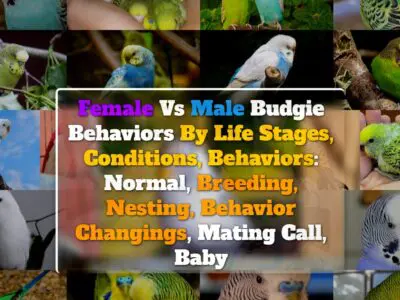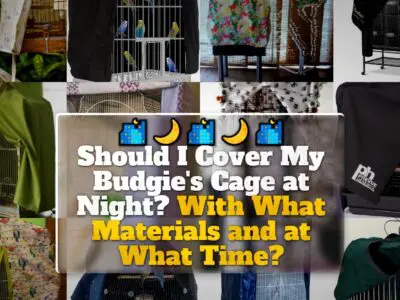Budgies usually nest in cavities they find in trees in their natural habitat. They decorate the inside of their nests by bringing materials such as feathers, bushes, and twigs they collect from outside to these tree holes.

On the other hand, budgie owners are inspired by nature to make budgie breeding boxes.
Why Do Budgies Need a Nesting Box?
During the breeding season, male and female budgies look for places such as tree cavities for their eggs and young to be healthy and safe to grow.
Domestic (captive) female budgies start looking for a safe place even if they are in cages, due to their nest-seeking instinct in their natural environment. If the budgie owner does not provide the female budgie with a nesting box, the female budgie will be under great stress.
To imitate the nesting behavior of captive male or female budgies in their natural environment, budgie owners provide a nesting box for each pair of budgies.
Thus, the processes of laying eggs and raising offspring continue smoothly without any stress.
What to Put Inside a Budgie Breeding Box?
The things you can put in a budgie breeding box should be chosen among materials that do not harm the budgies, are scentless, and can absorb ammonia and excess moisture.
Accordingly, the products that you can put in the budgerigar breeding box include coconut fibers, cotton, pine shavings, and scentless paper shreddings.

Take care not to put newspaper or magazine papers in budgie breeding boxes. Because the pages of newspapers and magazines often use chemicals that can harm budgerigars.
By becoming more humid over time, newspaper, and magazine papers can have an effect that can harm both parent budgies and baby budgies. You should also keep in mind that you don’t know what chemicals are used to create the colors on a newspaper or magazine page.
What Do Budgies Like in Their Nesting Box?
Budgies like soft materials such as feathers of various animals, twigs, and wood fibers for the breeding box floor in their nesting boxes, where they will lay their eggs and raise their budgie babies.
Where Do You Put a Nesting Box in a Budgie Cage?
Budgie nesting boxes should be hung on the outside of budgie cages. The hole of the nesting box should be opened into the cage, and budgies should be able to easily switch between the cage and the nesting box.
You should keep in mind that a breeding box placed inside the cage will narrow the budgies’ space in the cage and may stress them out.
Some female budgies in particular like to keep the male and other birds away from the breeding box. In this case, a breeding box placed inside the cage will put the female budgie under extremely high stress.
Budgie Nesting Box Size
The dimensions of the average nesting box suitable for budgies should be 12 inches (ca. 30 cm) long by 8 inches (ca. 20 cm) wide by 8 inches (ca. 20 cm) high.
For budgies such as the larger-sized English budgie, you can choose 14 inches (ca. 36 cm) long by 10 inches (ca. 25 cm) wide by 10 inches (ca. 25 cm) high breeding boxes. However, this was not necessary.
| Budgie type | Nesting box size |
|---|---|
| Normal budgies (small-sized) | 12×8×8 inches (ca. 30×20×20 cm) |
| English budgies (large-sized) | 14×10×10 inches (ca. 35×25×25 cm) |
English Budgie Nest Box Size
English budgies and large budgies may need nesting cages that are slightly larger than normal budgies due to their size. The nesting box size that a large budgie such as the English budgie would need would be around 14×10×10 inches (ca. 35×25×25 cm).
What are the Best Materials for Nesting Box for Budgies?
Wood materials are often considered the best materials for budgies, as budgies nest in tree cavities in their natural habitat. That’s why the best materials for budgie nesting boxes are materials like various wood fibers, coconut fibers, cotton, pine shavings, and scentless paper shreddings, and twigs.
What is the Best Type of Nesting Box for Budgies?
Budgie nesting boxes made of wood material better imitate budgie nests in natural environments. Therefore, the best kind of budgie nesting box is budgie nesting boxes made from wood materials.
What Do Budgies Use for Nesting?
In the wild, budgies use cavities in trees to build their nests, while budgies in captivity use nesting boxes that humans provide for them.
Do Budgies Like a Nesting Box?
Yes, budgies like nesting boxes. Male and female budgies usually have no problem with the nesting boxes that humans provide for them.
Can Budgies Mate Without a Nesting Box?
Yes, budgies will mate without a nesting box. Since budgie mating is largely dependent on hormones, everything else becomes less important. Budgies typically become interested in nesting boxes soon after mating.
However, you should keep in mind that immediately after mating, the female budgie will start looking for a suitable nest. The female budgie, who cannot find a suitable nest, can be under extremely high stress.
What Do Budgies Use for Nesting in the Wild?
Budgies living in the wild use tree cavities and safe shrubs for nesting.
How to Make a Nesting Box for Budgies?
You can use a variety of woods to make a homemade budgie nesting box. This process, which is not as difficult as it is known, can be done easily at home.
Budgies, especially female budgies, need a nesting box after mating to lay eggs and raise their budgie chicks healthily and safely. A female budgie without a nesting box will be under extremely high stress.



